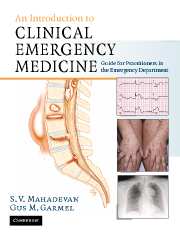Book contents
- Frontmatter
- Contents
- List of contributors
- Foreword
- Acknowledgments
- Dedication
- Section 1 Principles of Emergency Medicine
- Section 2 Primary Complaints
- 9 Abdominal pain
- 10 Abnormal behavior
- 11 Allergic reactions and anaphylactic syndromes
- 12 Altered mental status
- 13 Chest pain
- 14 Constipation
- 15 Crying and irritability
- 16 Diabetes-related emergencies
- 17 Diarrhea
- 18 Dizziness and vertigo
- 19 Ear pain, nosebleed and throat pain (ENT)
- 20 Extremity trauma
- 21 Eye pain, redness and visual loss
- 22 Fever in adults
- 23 Fever in children
- 24 Gastrointestinal bleeding
- 25 Headache
- 26 Hypertensive urgencies and emergencies
- 27 Joint pain
- 28 Low back pain
- 29 Pelvic pain
- 30 Rash
- 31 Scrotal pain
- 32 Seizures
- 33 Shortness of breath in adults
- 34 Shortness of breath in children
- 35 Syncope
- 36 Toxicologic emergencies
- 37 Urinary-related complaints
- 38 Vaginal bleeding
- 39 Vomiting
- 40 Weakness
- Section 3 Unique Issues in Emergency Medicine
- Section 4 Appendices
- Index
39 - Vomiting
Published online by Cambridge University Press: 27 October 2009
- Frontmatter
- Contents
- List of contributors
- Foreword
- Acknowledgments
- Dedication
- Section 1 Principles of Emergency Medicine
- Section 2 Primary Complaints
- 9 Abdominal pain
- 10 Abnormal behavior
- 11 Allergic reactions and anaphylactic syndromes
- 12 Altered mental status
- 13 Chest pain
- 14 Constipation
- 15 Crying and irritability
- 16 Diabetes-related emergencies
- 17 Diarrhea
- 18 Dizziness and vertigo
- 19 Ear pain, nosebleed and throat pain (ENT)
- 20 Extremity trauma
- 21 Eye pain, redness and visual loss
- 22 Fever in adults
- 23 Fever in children
- 24 Gastrointestinal bleeding
- 25 Headache
- 26 Hypertensive urgencies and emergencies
- 27 Joint pain
- 28 Low back pain
- 29 Pelvic pain
- 30 Rash
- 31 Scrotal pain
- 32 Seizures
- 33 Shortness of breath in adults
- 34 Shortness of breath in children
- 35 Syncope
- 36 Toxicologic emergencies
- 37 Urinary-related complaints
- 38 Vaginal bleeding
- 39 Vomiting
- 40 Weakness
- Section 3 Unique Issues in Emergency Medicine
- Section 4 Appendices
- Index
Summary
Scope of the problem
Vomiting is a common presenting complaint to the emergency department (ED), accounting for nearly 2 million annual visits. It has no age or gender predilection, and has many etiologies. The most common causes of vomiting are acute gastroenteritis, febrile systemic illness, and drug-related effects. The emergency physician's main responsibility is differentiating the emergent and life-threatening causes of vomiting from those caused by more benign entities. The remainder of ED management is targeted toward symptom alleviation and rehydration.
Pathophysiology
Vomiting is induced by physical stimulation of the back of the throat (gag reflex), mucosal irritation of the upper digestive tract, stimulation of the vomiting center in the medulla oblongata, stimulation by biochemical emetic stimuli on the chemoreceptor trigger zone in the area postrema, or by severe emotion. Nausea frequently precedes vomiting and is marked by reduced gastric tone and peristalsis. Regurgitation, by contrast, is the passive retrograde movement of esophageal contents into the mouth, as in gastroesophageal reflux.
True vomiting refers to the rapid ejection of gastric contents. The abdominal muscles rapidly contract, while the cardia of the stomach, esophagus, and throat remain open with the glottis closed. Copious salivation usually precedes vomiting, and serves to lubricate the digestive tract and dilute the gastric acid. Repeated contractions of the abdominal muscles against a relaxed stomach produce retching. The repetitive abdominal contractions build up a pressure gradient in the stomach prior to vomiting. This allows gastric contents to move to the upper portion of the stomach.
- Type
- Chapter
- Information
- An Introduction to Clinical Emergency MedicineGuide for Practitioners in the Emergency Department, pp. 569 - 580Publisher: Cambridge University PressPrint publication year: 2005

